The next day I planned to visit several interesting towns east of Nice, but first I headed a little bit to the west from the main train station in Nice, since there were two places I wanted to visit there. The first one was a bakery that makes artisanal croissants, which means butter croissants, and there I had my breakfast.
The second place was all but profane, like the bakery, and it was the Russian Orthodox Cathedral of St. Nicholas.
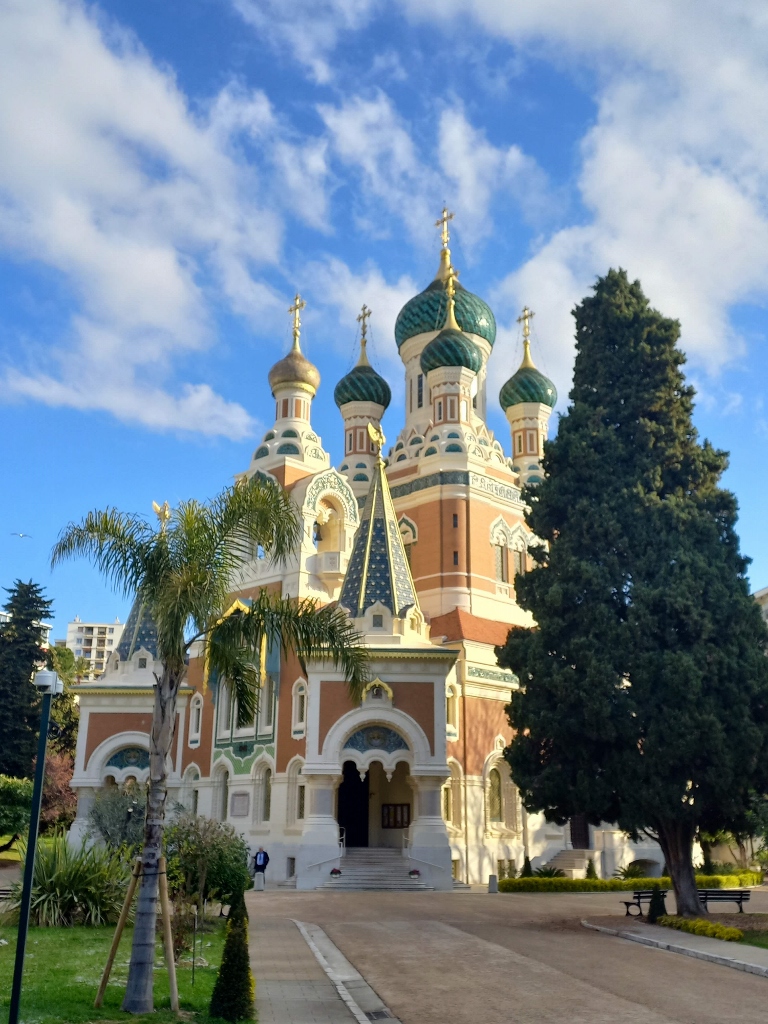 Church of St. Nicholas in Nice
Church of St. Nicholas in Nice
I had already made plans to come to this church in a couple of days in order to attend the liturgy celebrating the Annunciation that was to be led jointly by the Russian and Serbian orthodox priests, but since I was nearby, I decided to come here right away. Still, I could not get in, since the gates open only at 10 am, but I did take a couple of photos from the front of the church. Then I walked around and managed to get some photos from the back side.
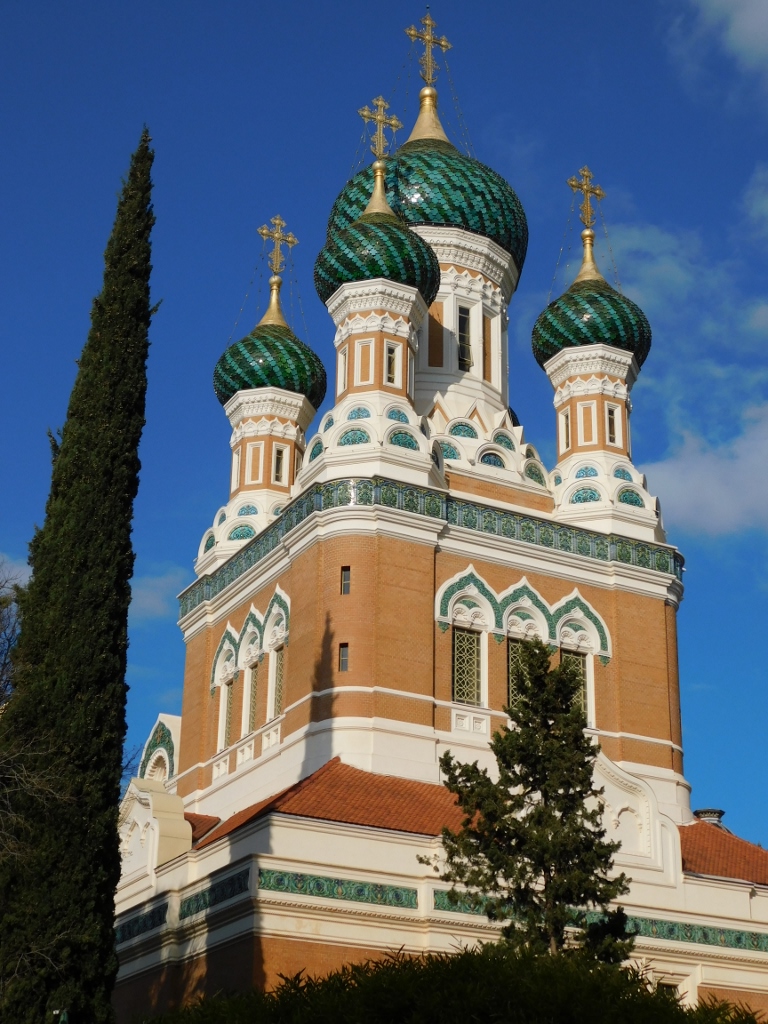 Church of St. Nicholas in Nice
Church of St. Nicholas in Nice
Taking into account that the Russian aristocracy followed the trends of their western counterparts, they also “discovered” French Riviera over time. Since 1864 and the visit to Nice by Emperor Alexander II, members of the Russian nobility started to come here regularly and hence there was a need for a church. On the other hand, the heir apparent, Tsesarevich Nicholas (1843-1865), died precisely in Nice and thus the first to be built was the Chapel of Tsesarevich Nicholas Alexandrovich (it was constructed in 1867-1868). Several dozen metres farther, on the same plot of land, the construction of a large cathedral was finished in 1912. This is the largest orthodox cathedral in Western Europe. The construction was financed by Emperor Nicholas II.
Owing to the events that took place in Russia in 1917, the Cathedral of St. Nicholas in Nice was separated from Moscow for a longer period of time, but a court proceeding was initiated at the beginning of the 21st century and thus both churches, as well as the parcel of land on which they are located, belonged to the Russian Federation, which on its side ceded the church to the Patriarchate of Moscow.
Having taken photos of the Church of St. Nicholas from the outside, I simply returned to the main train station in Nice. The train station was opened in 1864 and it was precisely by rail that Emperor Alexander II first came here.
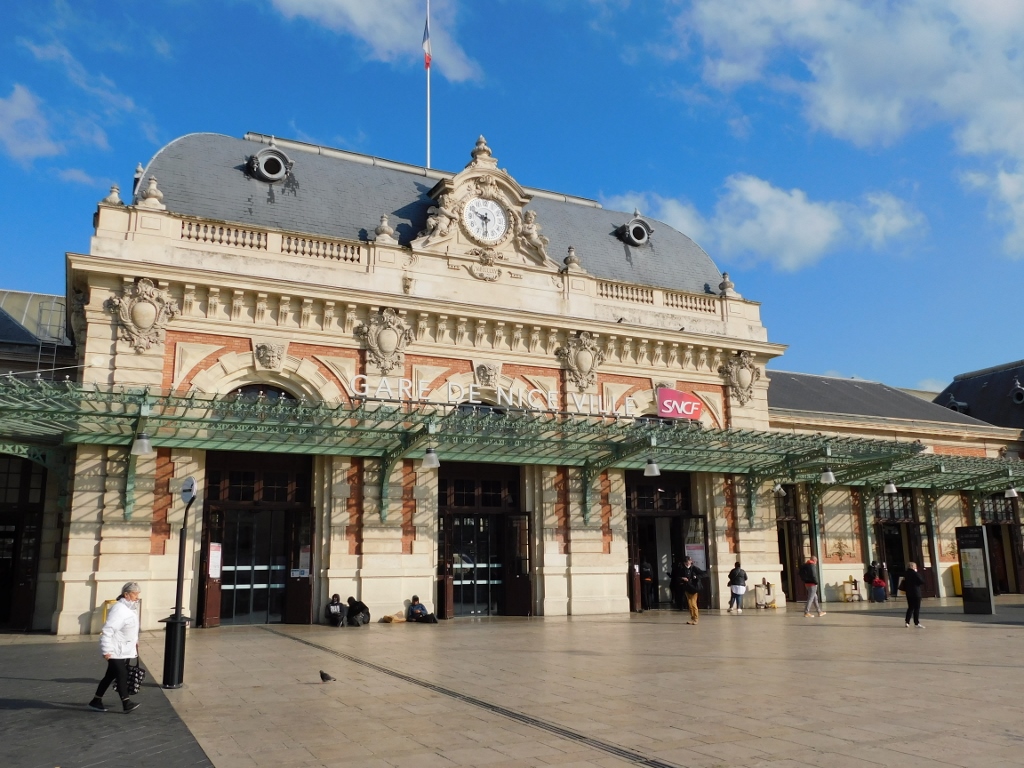 Main train station in Nice
Main train station in Nice
My plan was to buy a return ticket to the town of Menton and then on my way back to make stops at different stations in order to visit a few more places. The train actually runs to Italy, to the town of Ventimiglia which is the first along the railway line once you’ve crossed the border, but my plan was not to go all the way there, but only as far as Menton. The plan was excellent and it allowed me to visit a lot during a single day, but the things got a little complicated owing to the cancellation of some trains. Still, by the end of the day I succeeded in seeing what I was interested in. To start with, I waited for a train in Nice for almost an hour, but I did arrive well in Menton.
The historians have established that there was a settlement in Menton already during the Neolithic times, but as far as the history of this small town is concerned, it is interesting that in the 14th century it was bought by Grimaldi family of Monaco. Still, when France annexed Nice, in the second half of the 19th century, Menton was encompassed by this annexation.
The town is renowned for its gardens, since this is allowed by the mild Mediterranean climate, while there were several entrepreneurial individuals who at the beginning of the 20th century laid down the ground plans for various exotic gardens. One of the best known in the Botanical Garden (Jardin botanique Val Rahmeh-Menton) that is situated a little over 1 km from downtown Menton. I must say that, unfortunately, I did not get to see any of these gardens. The reason was that I did not have enough time for a thorough sightseeing of the place. I think that Menton absolutely deserves a whole, relaxed day, during which one can visit the town and its gardens, it is also possible to walk by the sea, enjoy some local food, etc. However, since I had only a week for the whole of French Riviera, I simply could not afford to dedicate a whole day to Menton alone. Perhaps I may remedy this on some other occasion. Still, I cannot say that in the end I was not content with what I did see and visit.
To start with, I headed from the train station towards the sea and thus I crossed around the Victories Square (Place de Victoires).
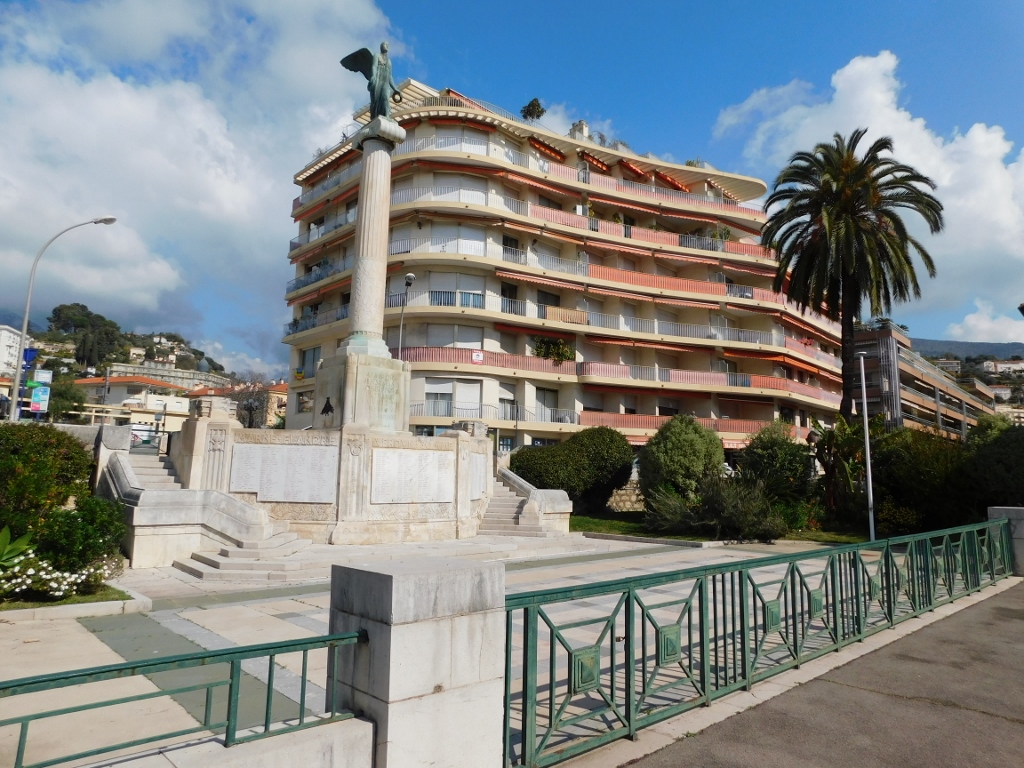 Menton, Victories Square
Menton, Victories Square
I also walked past the Palace of Europe (Palais de l’Europe) that hosts the Menton Tourist Office.
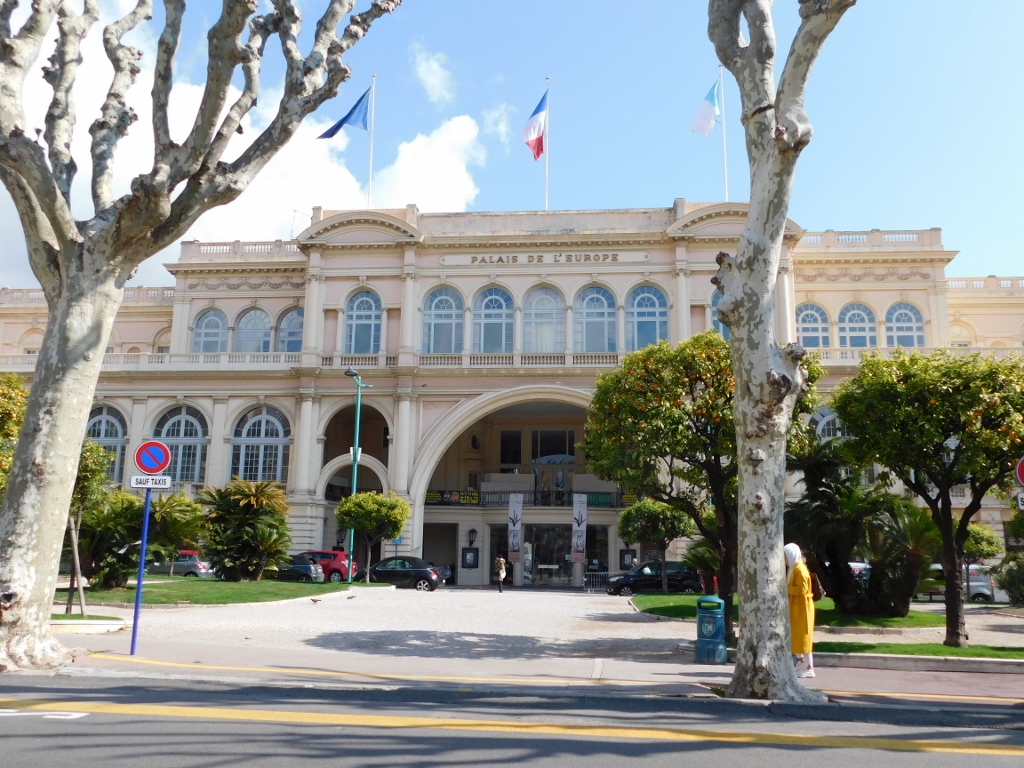 Menton, Palace of Europe
Menton, Palace of Europe
I went beside the Casino as well, since gambling is a serious sport on the French Riviera, especially bearing in mind the very wealthy residents or seasonal visitors. Yet, I was not interested in this in the least and only continued to the beach on the shore of the Mediterranean Sea.
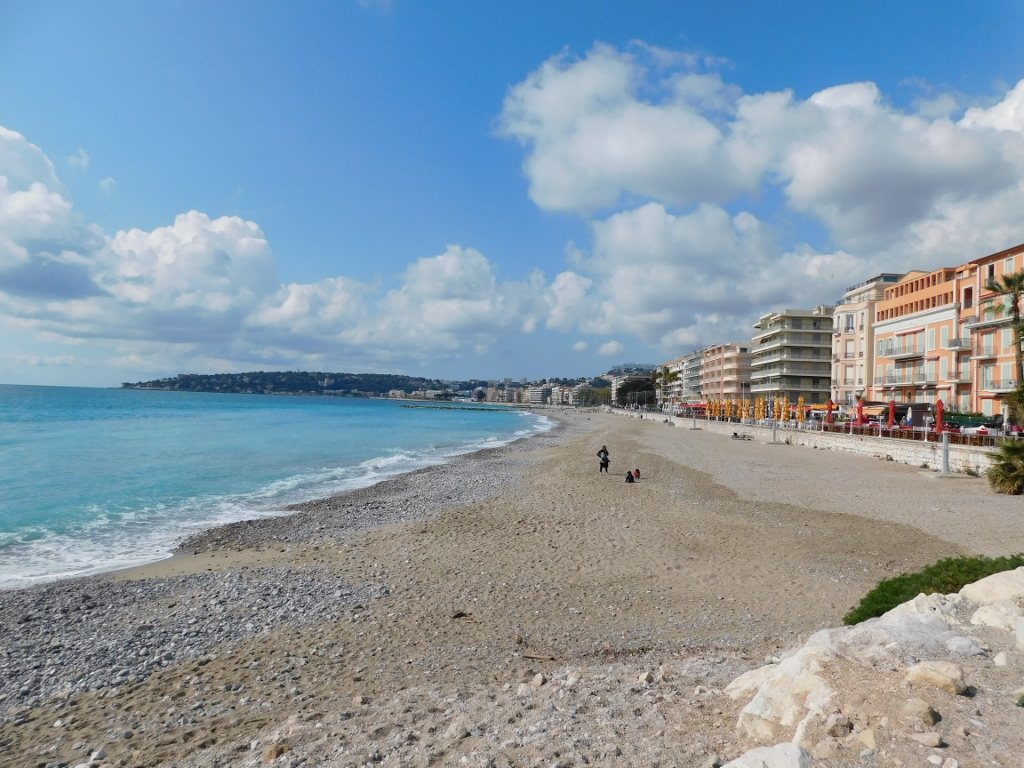 Menton, the beach
Menton, the beach
 Menton, the beach
Menton, the beach
While going along the shore, I noticed a bird that casually walked along the bed of the river Borrigo that flows into the sea here.
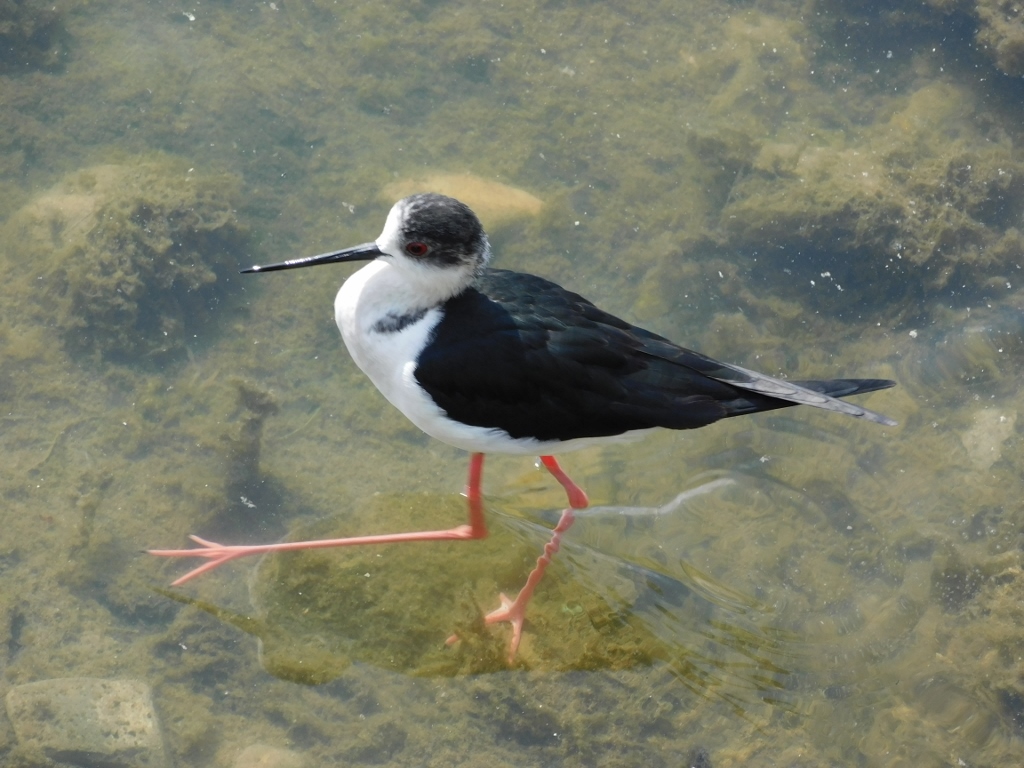 Black-winged stilt (Himantopus himantopus)
Black-winged stilt (Himantopus himantopus)
As it may be concluded from the photos, although it was a sunny day, it was the beginning of April and there was nobody on the beach in order to go swimming. What cannot be concluded from the photos is that it was in fact rather chilly, since there was a strong cold wind; so much so that I had to put my cap on. I did try to ignore the wind, even taking a seat in a café near the beach with an intention to make a break there, but I gave up soon, continuing instead with my stroll to the end of the beach in the Sun Bay (Baie du Soleil). There I took yet another photo of the beach and the urban parts of Menton.
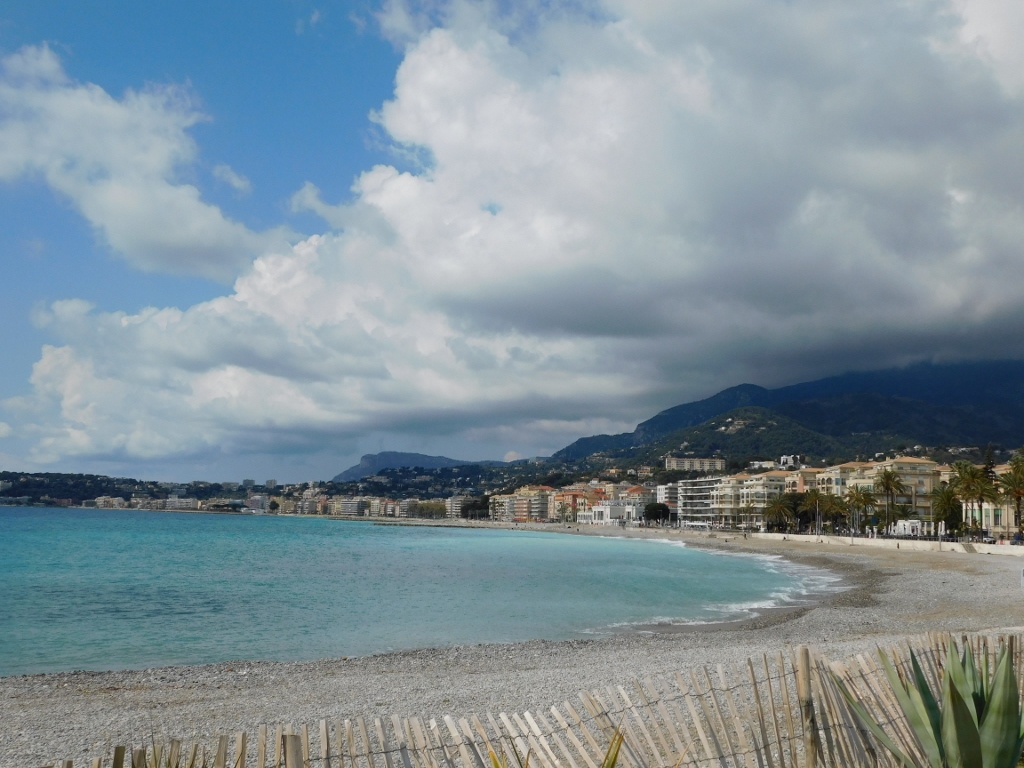 Menton, the beach
Menton, the beach
At the end of the beach there are as many as two museums dedicated to Jean Cocteau (1889-1963). To start with, Jean Cocteau was a French poet, novelist, playwright, designer, painter, visual artist, etc. Within the scope of his numerous and diverse artistic activities he went practically through all the phases of the modern art. From 1950, he started to come to the French Riviera regularly and from 1955 he was particularly linked to Menton. And so the mayor, whom he had befriended in the meantime, proposed that he decorated the Wedding Hall at the Town Hall. This hall has been serving this function to the present times.
At the end of 1957, that same mayor offered to Cocteau to create a museum at the Bastion, a small fortification on the very shore which was built on the orders of the then Prince of Monaco in the first half of the 17th century. And so it happened and the museum was opened in 1966, three years after the death of Cocteau, under the name of the Bastion Museum.
It is interesting that the town of Menton, whose honorary citizen Cocteau was, wanted to open yet another museum dedicated to Jean Cocteau and this museum was opened in 2011 under the name of the Museum Jean Cocteau. This second museum includes the collection of an American businessman who was particularly fond of Cocteau’s works and it is located only a couple of hundred metres from the Bastion Museum. In 2018, Menton was hit by a very strong storm and on that occasion the sea water flooded the basement in which some Cocteau’s works were stored, as well as the ground floor. Since then, the museum has been temporarily closed until the damaged works have been restored.
I had no intention of visiting the museums, but I did walk past the Museum Jean Cocteau, so I took a photo of it.
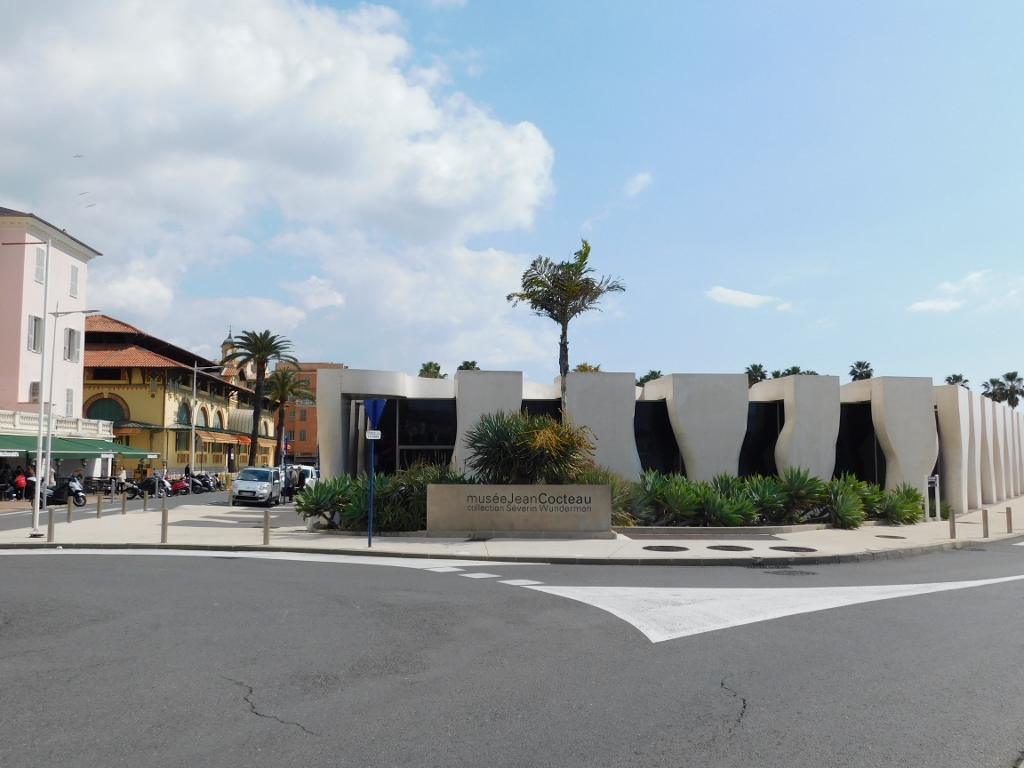 Temporarily closed Museum Jean Cocteau in Menton
Temporarily closed Museum Jean Cocteau in Menton
Left of the museum, in the photo above, one can see a yellow building. This is the central market in Menton which I found much more attractive.
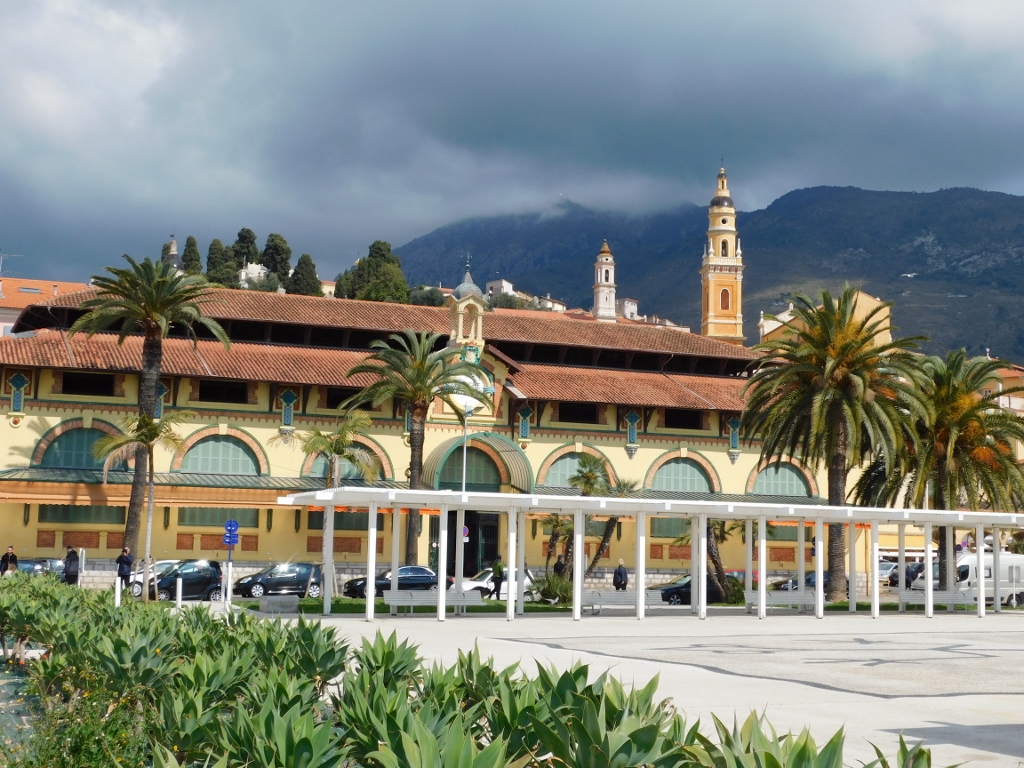 Central market in Menton
Central market in Menton
In addition to the picturesque market, from the plateau by the museum I could also see nicely the towers of a couple of churches and the one that stood out in particular was the tower of the Basilica of Saint-Michael the Archangel which soon I went to see.
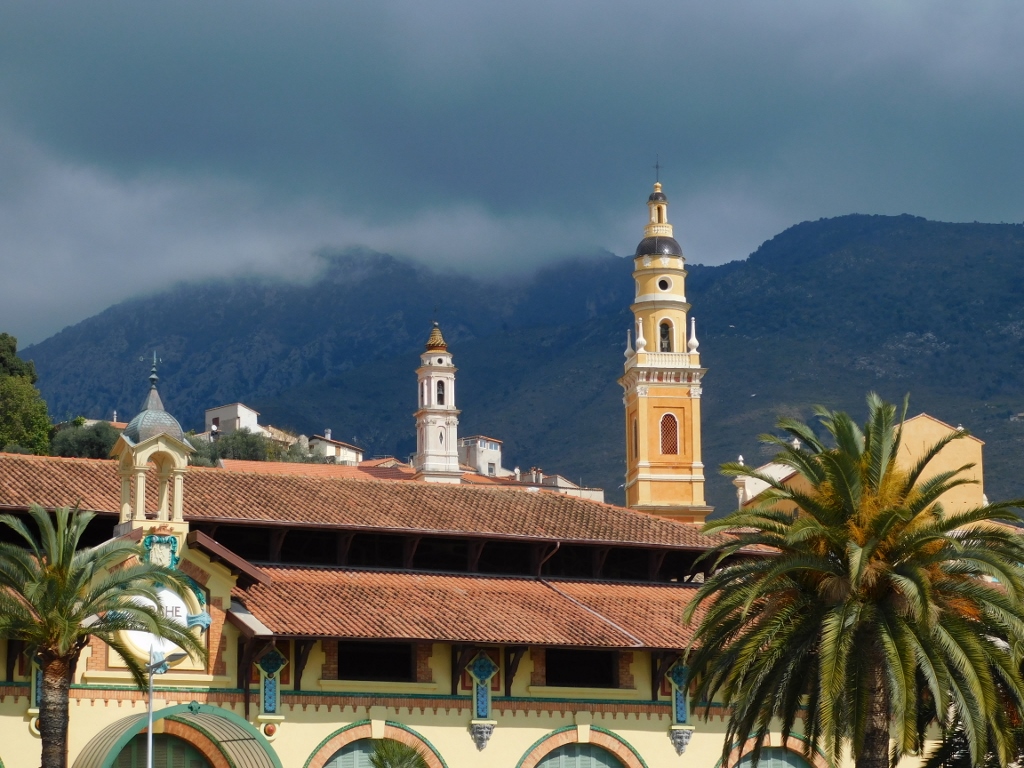 Market and the tower of the Basilica of Saint-Michael the Archangel
Market and the tower of the Basilica of Saint-Michael the Archangel
Still, I went to the market first.
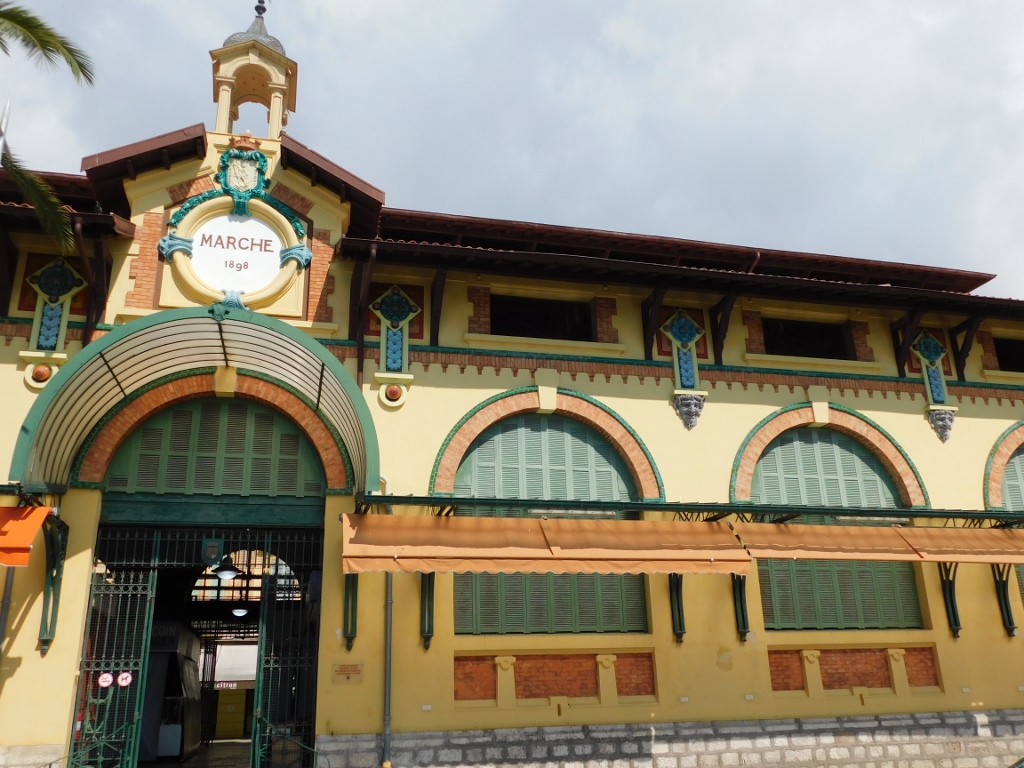 Central market in Menton
Central market in Menton
There were different stands in the central market, of course, but the one that caught my attention the most was the one with fresh meat, especially the part with poultry. There were different varieties of chickens, turkey, as well as pigeons, quails, guinea fowl and rabbits (for some reason, it was emphasised that those last ones had black eyes). Although I know nothing about rabbits, it was quite clear that I was in France.
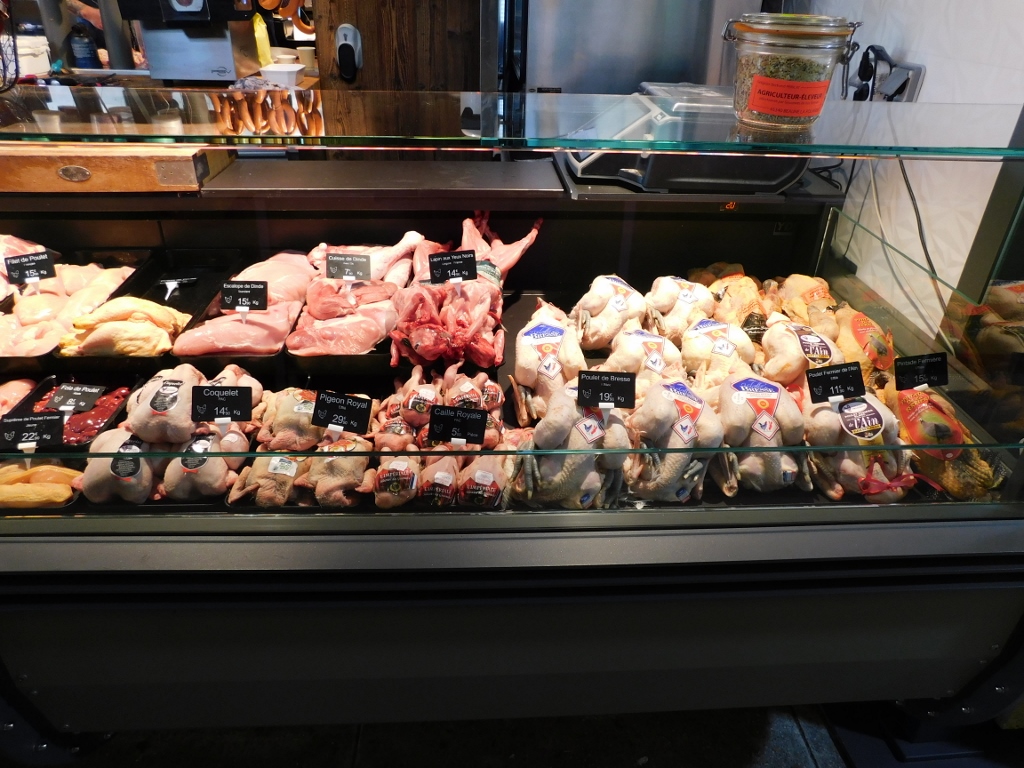 Central market in Menton, a detail
Central market in Menton, a detail
After the visit to the central market, I entered the old part of Menton. There were restaurants and cafés, as well as many shops with the goods for tourists.
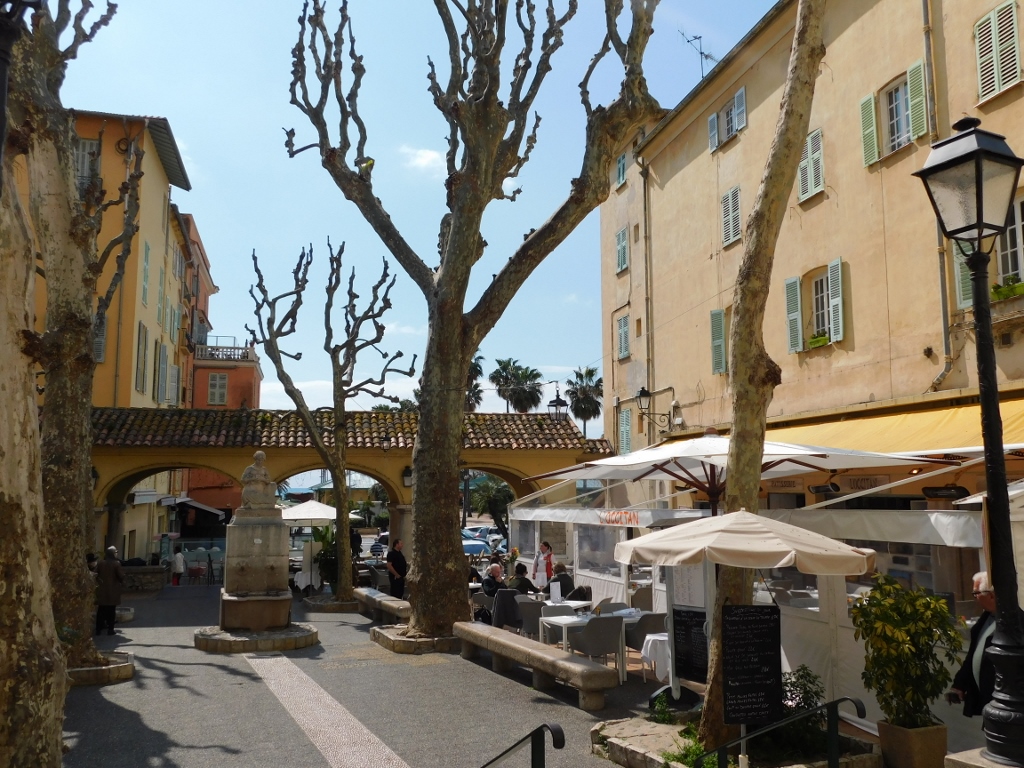 Menton, a detail
Menton, a detail
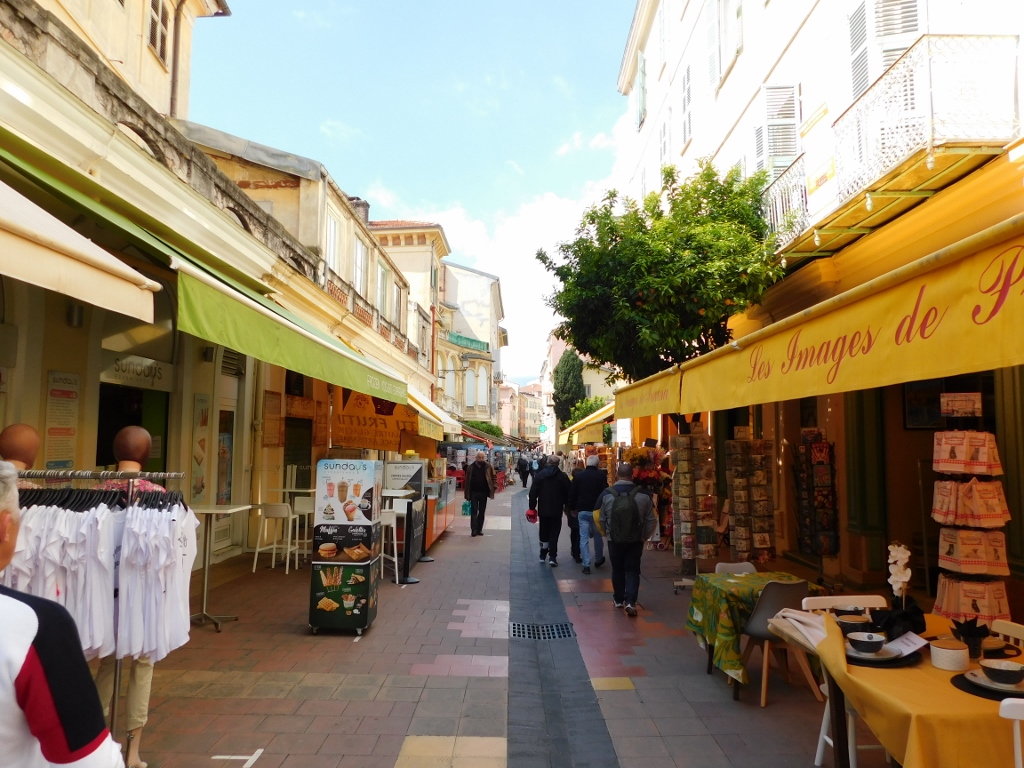 Menton, a detail
Menton, a detail
I was not interested in any of that, but rather my plan was to follow some side streets and passages, such as the one that can be seen in the photo below.
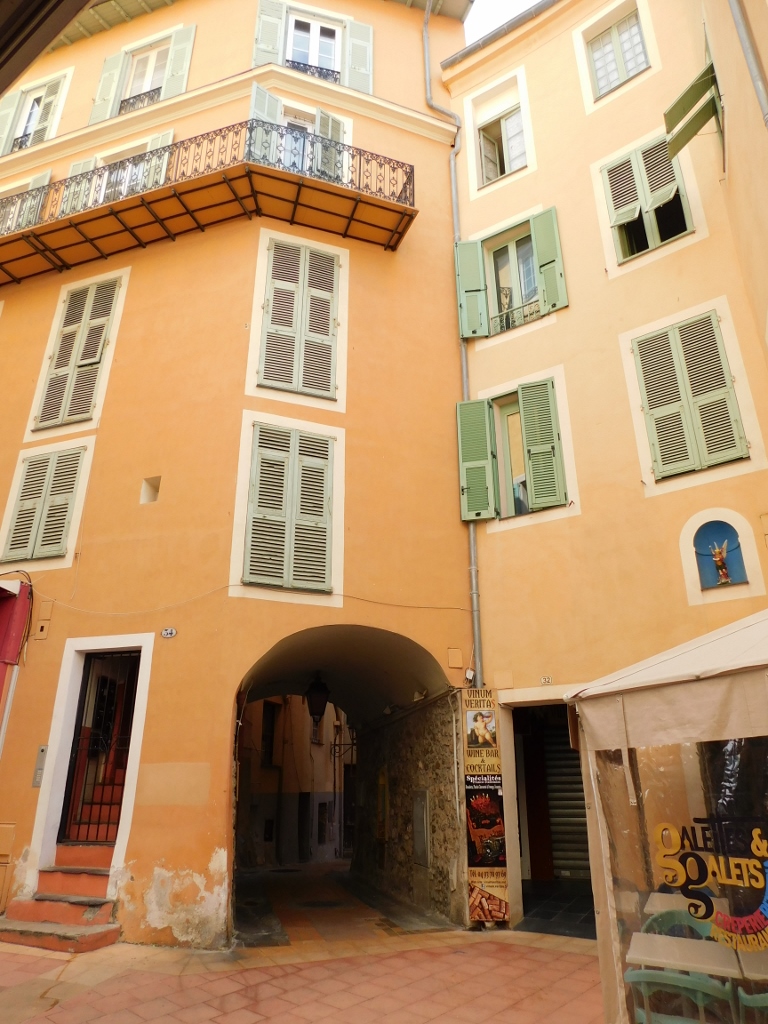 Menton, a detail
Menton, a detail
My goal was to get to the Basilica of Saint-Michael the Archangel, the tower of which I had seen from the shore and which could still be seen from the surrounding streets from time to time.
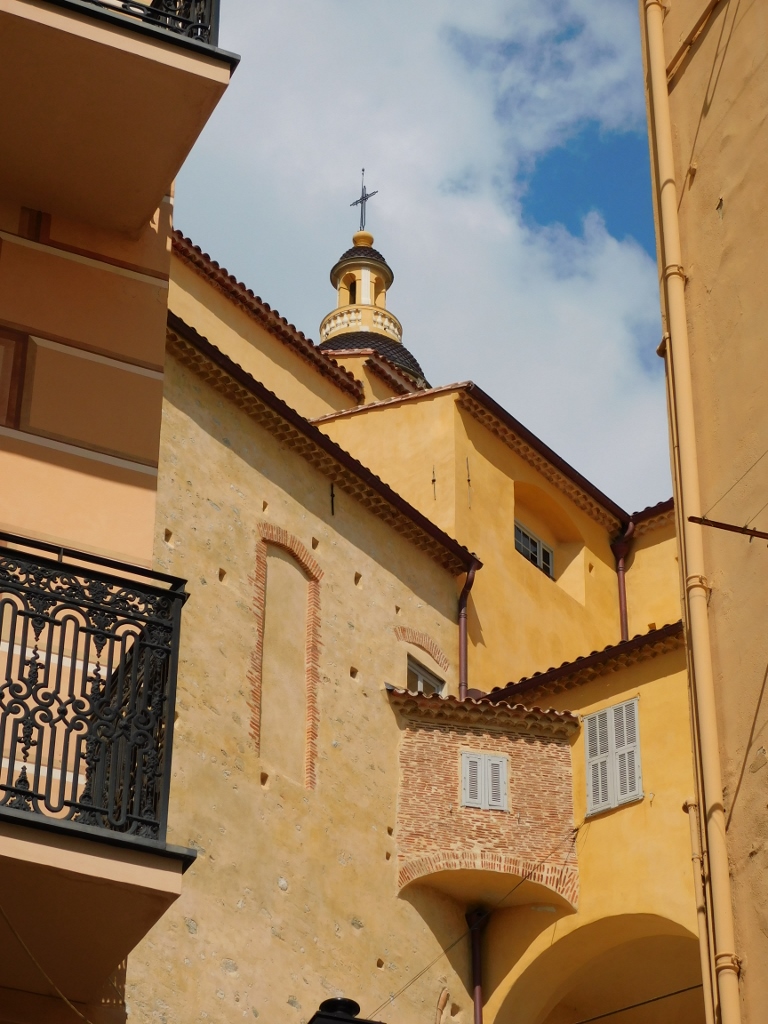 Menton, a detail
Menton, a detail
Still, I first walked to the east part of Menton where there is a beach, a small port, as well as Italy. In the following photo, the hill covered in trees that can be seen in the middle is already Italy.
 View at the beach and Italy
View at the beach and Italy
And then I started to climb the often narrow streets that can also be defined as wide staircases and that are characteristic of the old part of Menton. In any case, it was very picturesque.
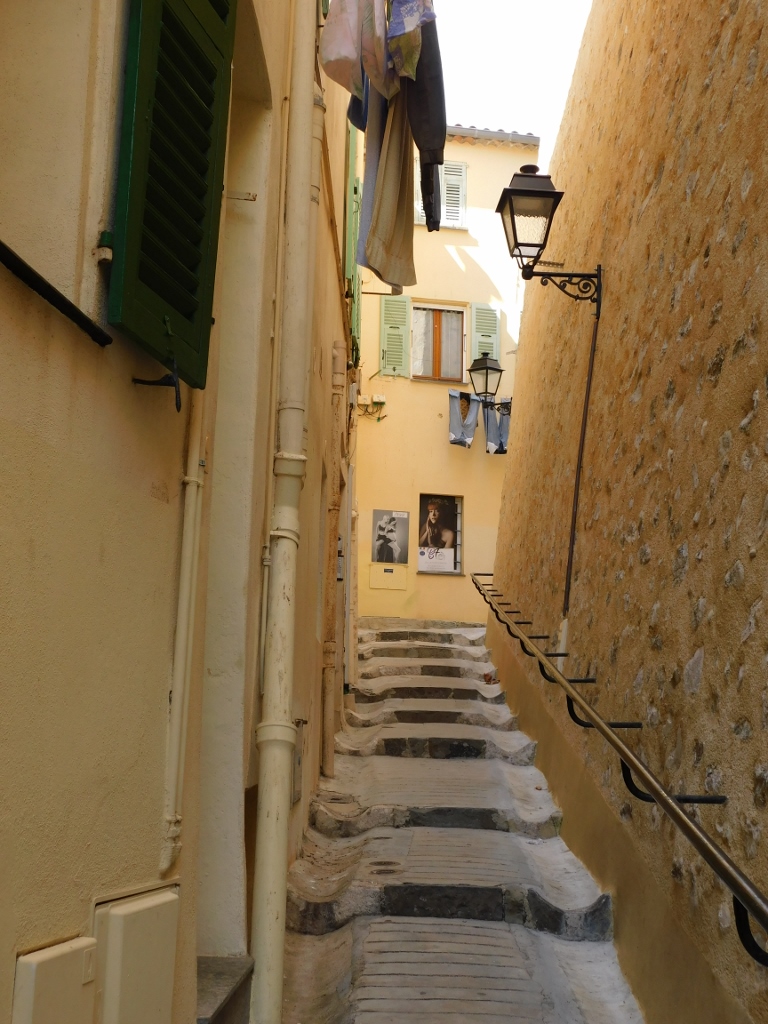 Menton, a detail
Menton, a detail
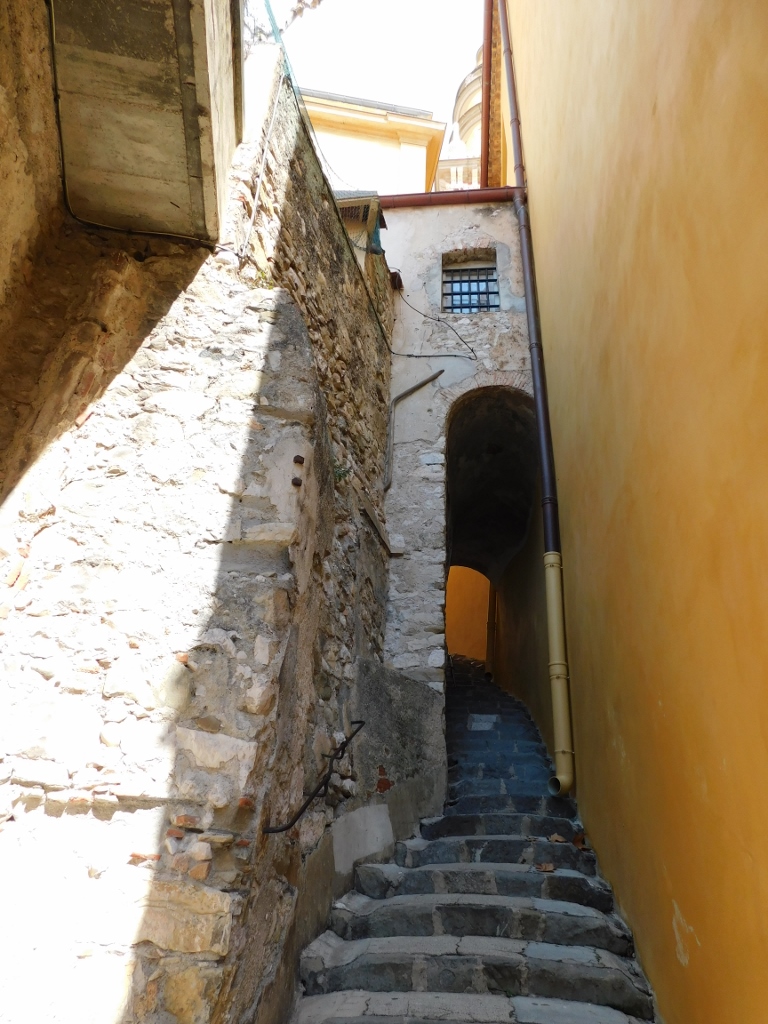 Menton, a detail
Menton, a detail
I did all of this in order to get to two churches. The route led me to the plateau in front of one church and from there, “one floor below,” there was a lovely adjacent plateau in front of the other church. There was also the view of the sea, the east part of Menton and again – Italy.
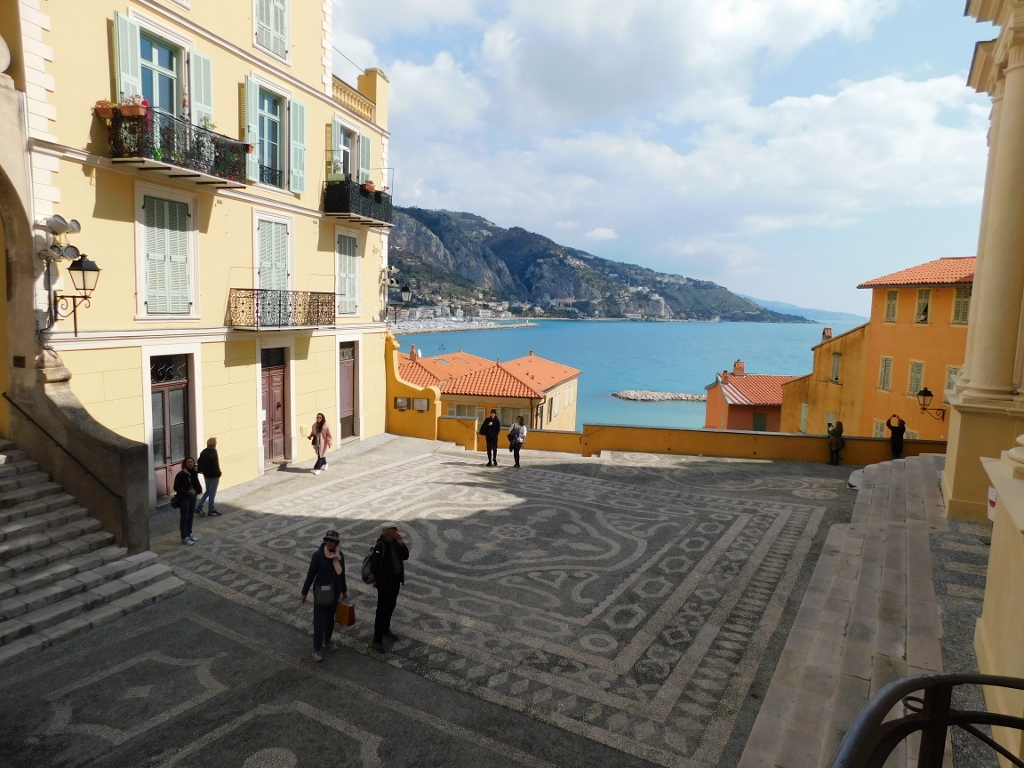 Plateau in front of the Basilica of Saint-Michael the Archangel
Plateau in front of the Basilica of Saint-Michael the Archangel
This plateau, i.e., the square seen in the photo above was made at the time when Menton belonged to the Grimaldi family (the present-day rulers of Monaco), so apparently even their family monogram may be seen in the mosaic made of pebbles that paves the square. It is possible to descend to the shore from the square using St. Michael’s Steps (Rampe St-Michel) and the steps start right at the yellow wall that is seen at the end of the square in the photo above. The view at these steps is more beautiful when they are looked at from the shore. However, after this I wanted to go in the completely opposite direction (I needed to head slowly back towards the train station), so I did not deal with the steps any longer, but I’m mentioning them in case somebody goes to Menton and wants to see them.
Be as it may, here I first noted the Chapel of the Immaculate Conception (Chapelle de l'Immaculée-Conception) that is located at the higher level in comparison to the other church.
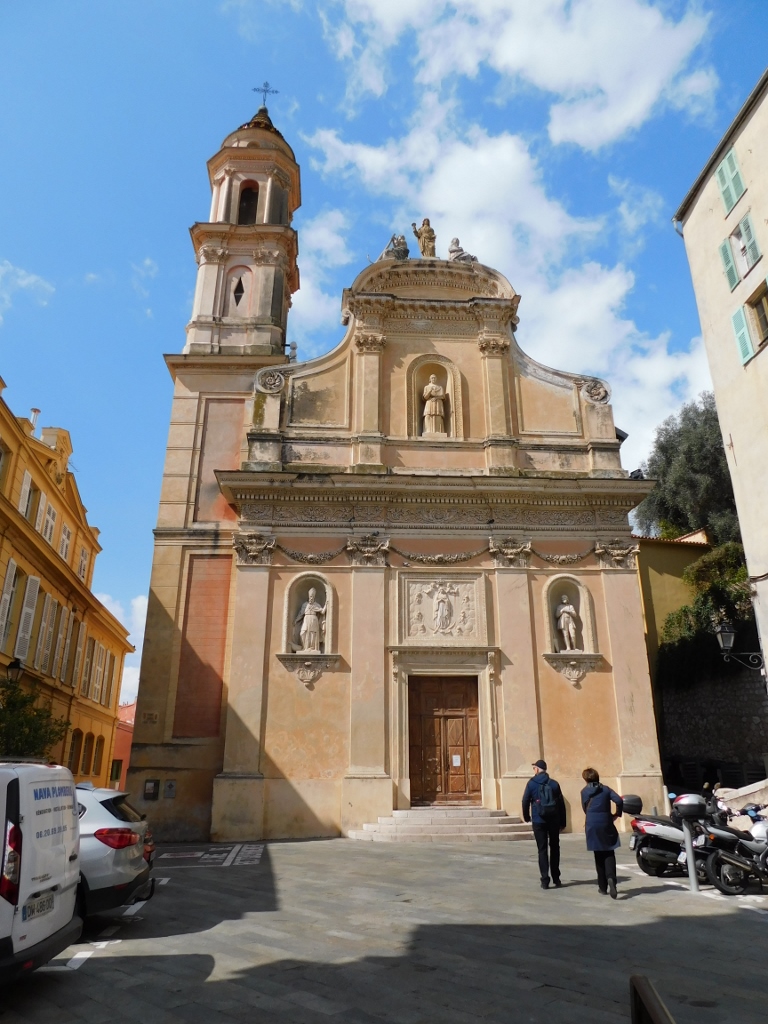 Chapel of the Immaculate Conception
Chapel of the Immaculate Conception
This church is also known under the name of the Chapel of the White Penitents, after a branch of the Confraternity of Penitents that is rather popular in the Catholic Church. This chapel with Baroque facade was built between 1680 and 1687. It was significantly damaged in the 1887 earthquake, but it has been restored over time and is considered a historical monument.
Then I went down to the square in front of the other church and that was the Basilica of Saint-Michael the Archangel (Basilique Saint-Michel Archange de Menton), the tower of which is the most noticeable when looking towards this part of the town. However, it is more difficult to grasp the entire church from the square, so I climbed a staircase opposite of the church in order to get a better photo.
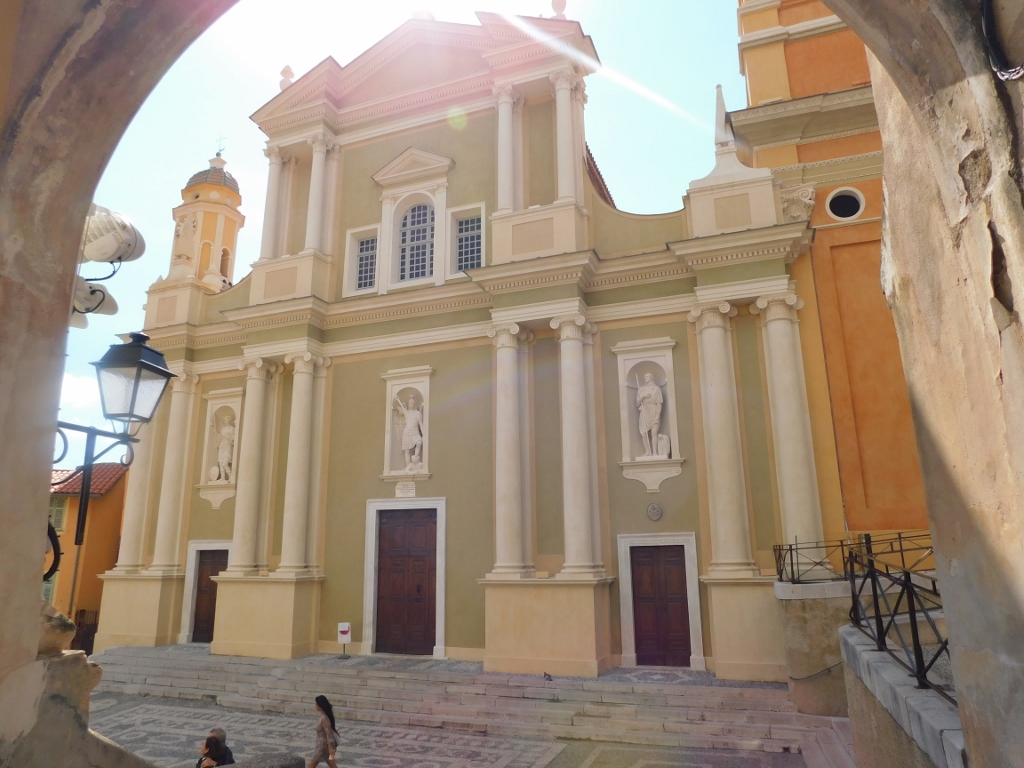 Basilica of Saint-Michael the Archangel
Basilica of Saint-Michael the Archangel
The Basilica of Saint-Michael the Archangel is a Baroque church built around the middle of the 17th century. The 1887 earthquake shook seriously this church as well, but it has been restored. But, the church is not opened for visits all the time and on all days, and when it is open this is usually in the afternoon.
Here I also moved to the side a little and then I could take a photo of the Basilica’s tower, being one of the main landmarks of Menton, as well as the tower of the Chapel.
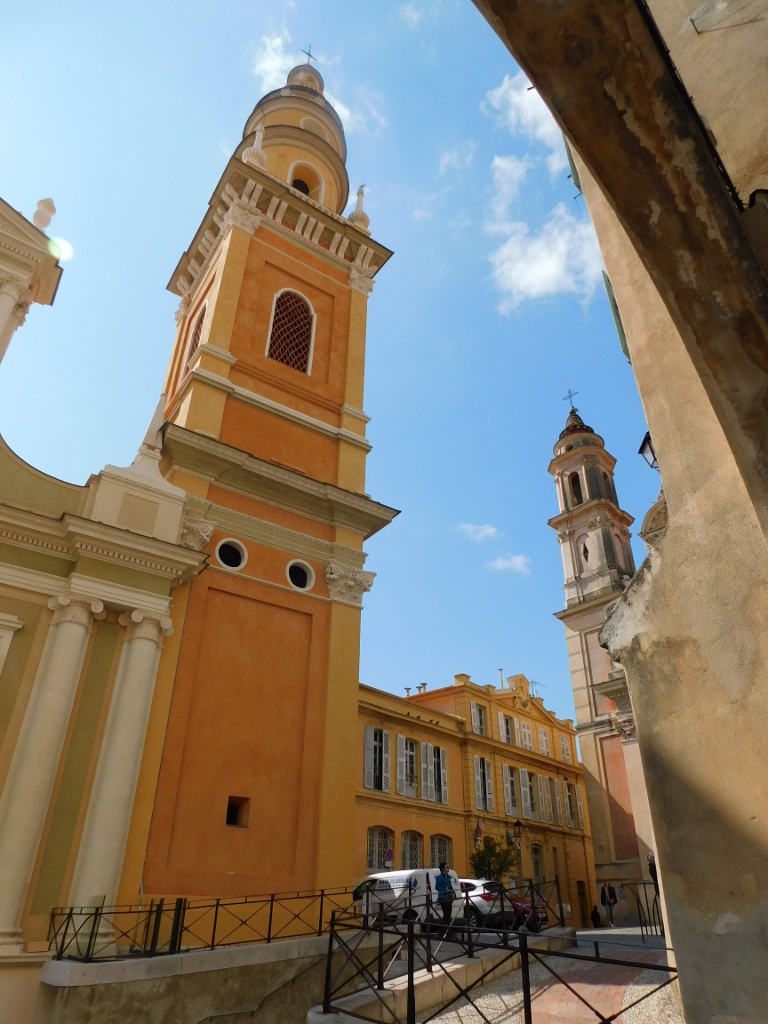 Tower of the Basilica of Saint-Michael the Archangel and the tower of the Chapel of the Immaculate Conception
Tower of the Basilica of Saint-Michael the Archangel and the tower of the Chapel of the Immaculate Conception
Behind me there were again some stairs that went further uphill, but, as I’ve said, now I started to descend towards the main street for visitors and tourists, and that is Rue Saint-Michel.
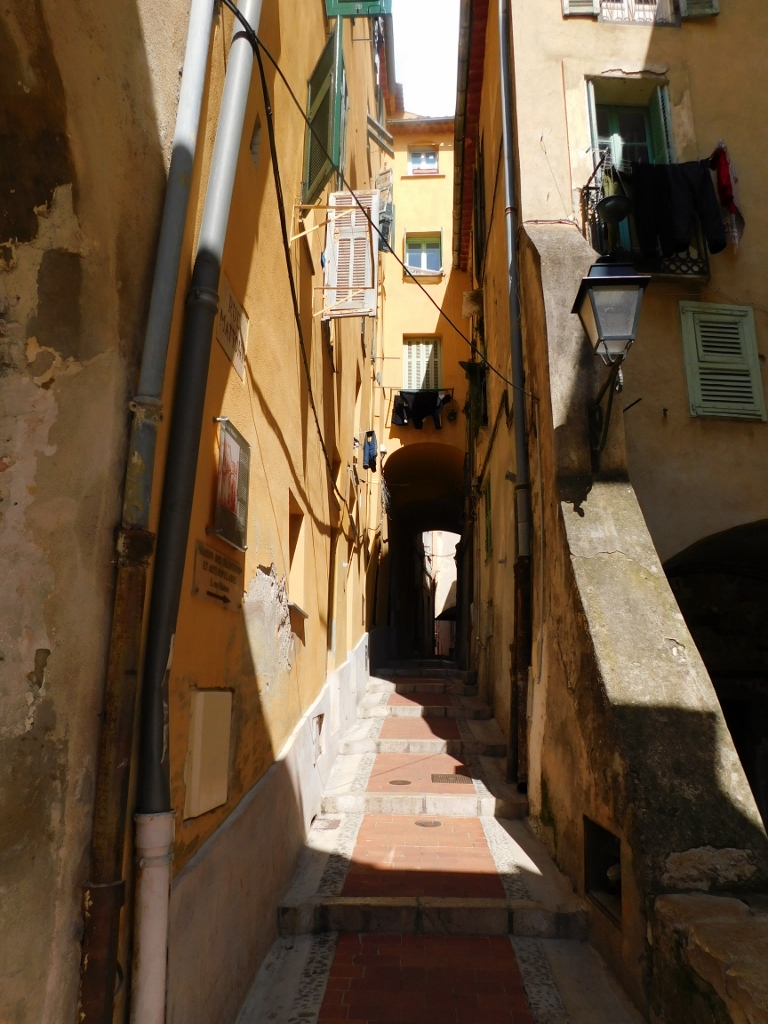 Street leading uphill from the square in front of the Basilica of Saint-Michael the Archangel
Street leading uphill from the square in front of the Basilica of Saint-Michael the Archangel
Walking down the streets with steps, I could enjoy the beautiful details that are abundant in Menton. The town in itself is exceptionally pretty and its residents obviously feel the need to beautify it additionally.
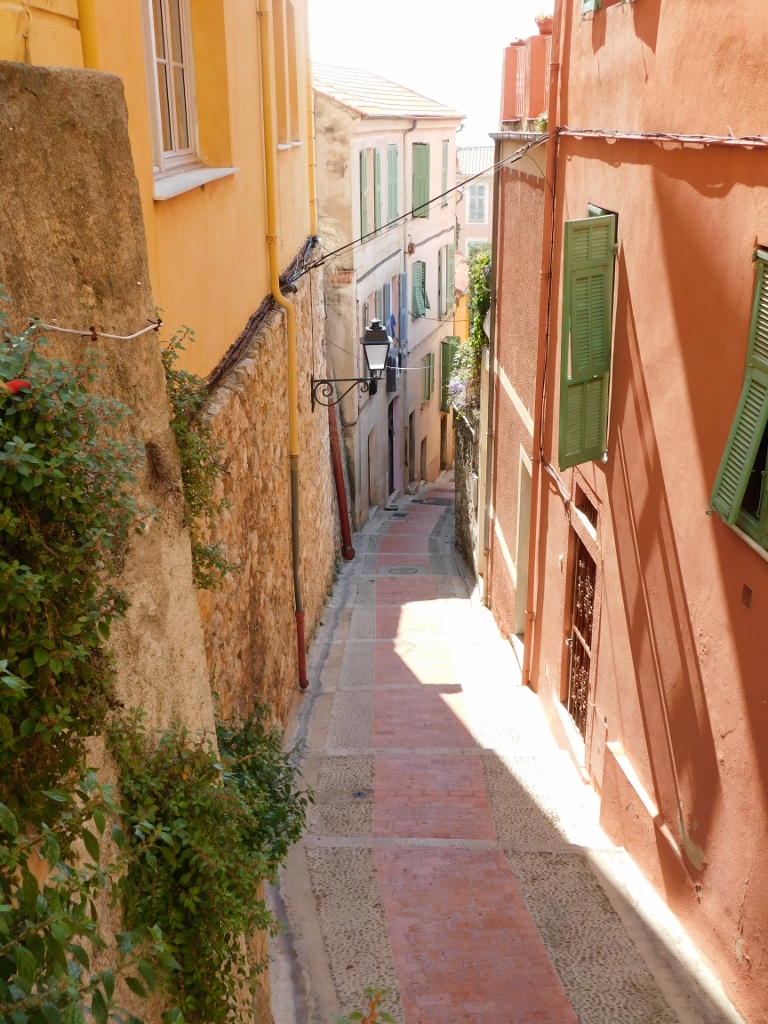 Menton, a detail
Menton, a detail
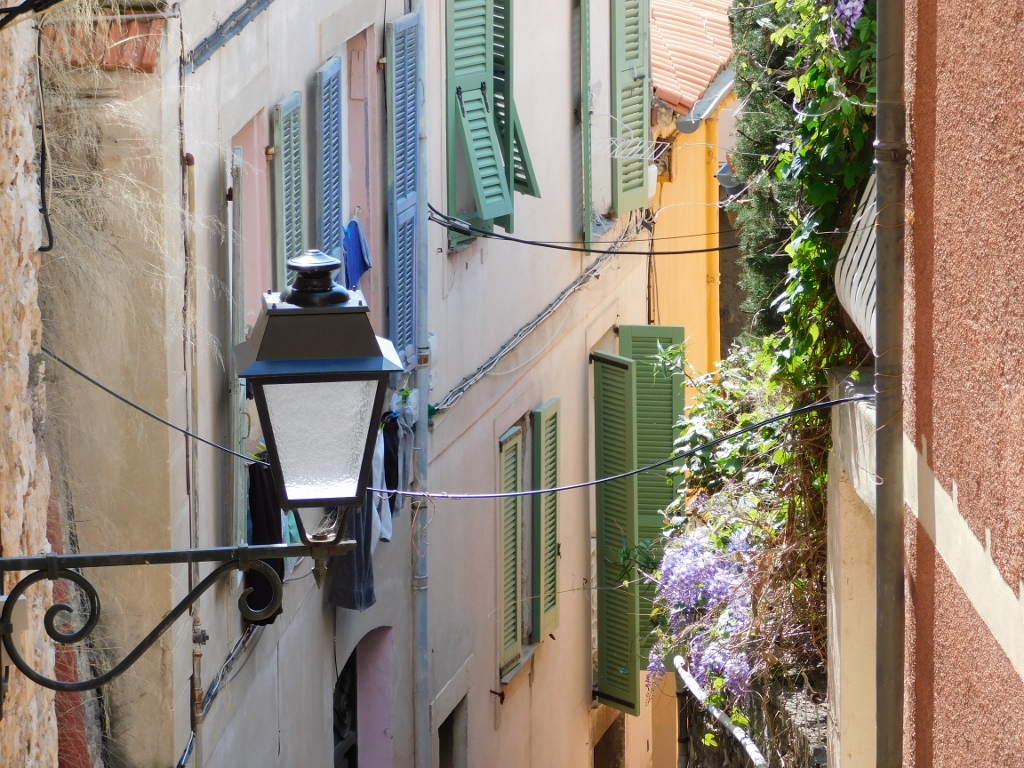 Menton, a detail
Menton, a detail
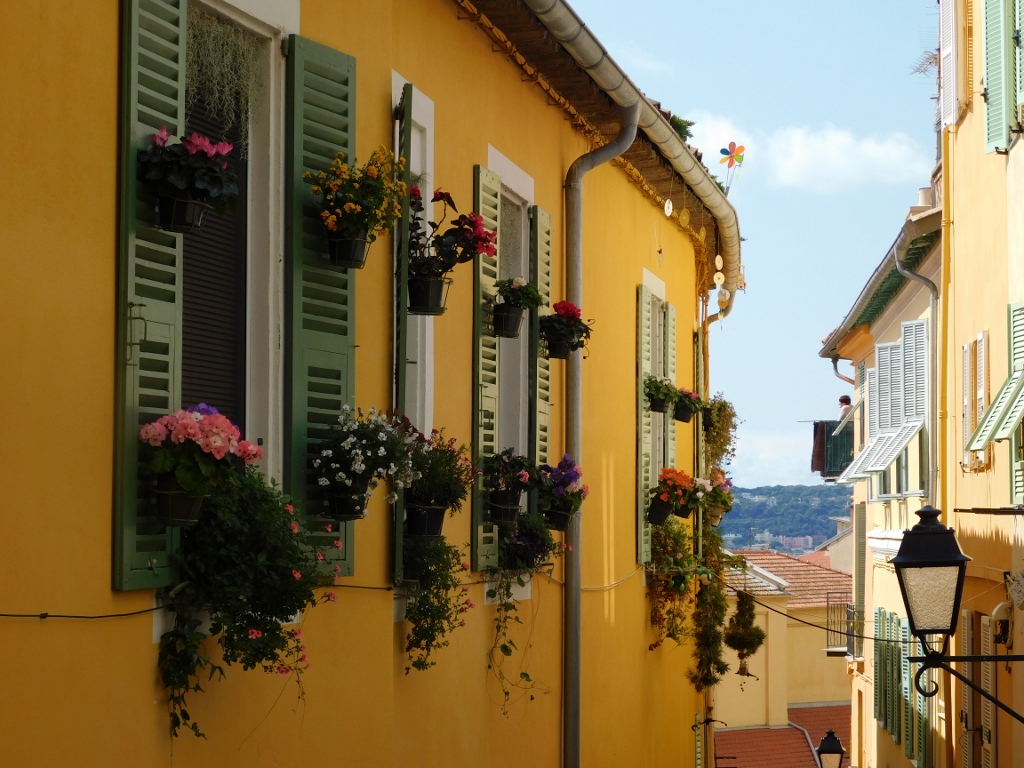 Menton, a detail
Menton, a detail
Soon I reached the Chapel of Mercy (Chapelle Miséricorde), also known by the name of the Chapel of the Black Penitents, again one of the brotherhoods of the Catholic Church.
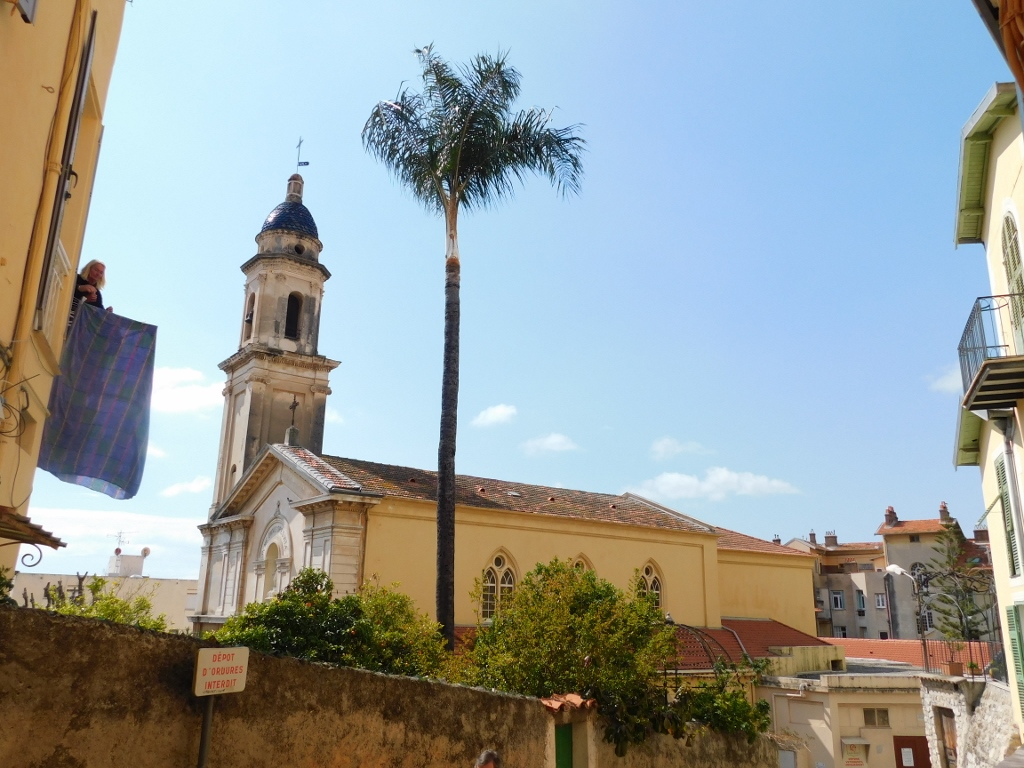 Chapel of Mercy
Chapel of Mercy
The chapel was built in the 17th century for the needs of the Capuchins (that separated from the Franciscans around the middle of the 16th century) and at the time the facade was simple and stern, in line with the teachings of St. Francis. However, over time, the chapel kept changing its function and owners and in 1875 it got a new, altered facade. Nowadays, it is linked to the Confraternity of the Black Penitents.
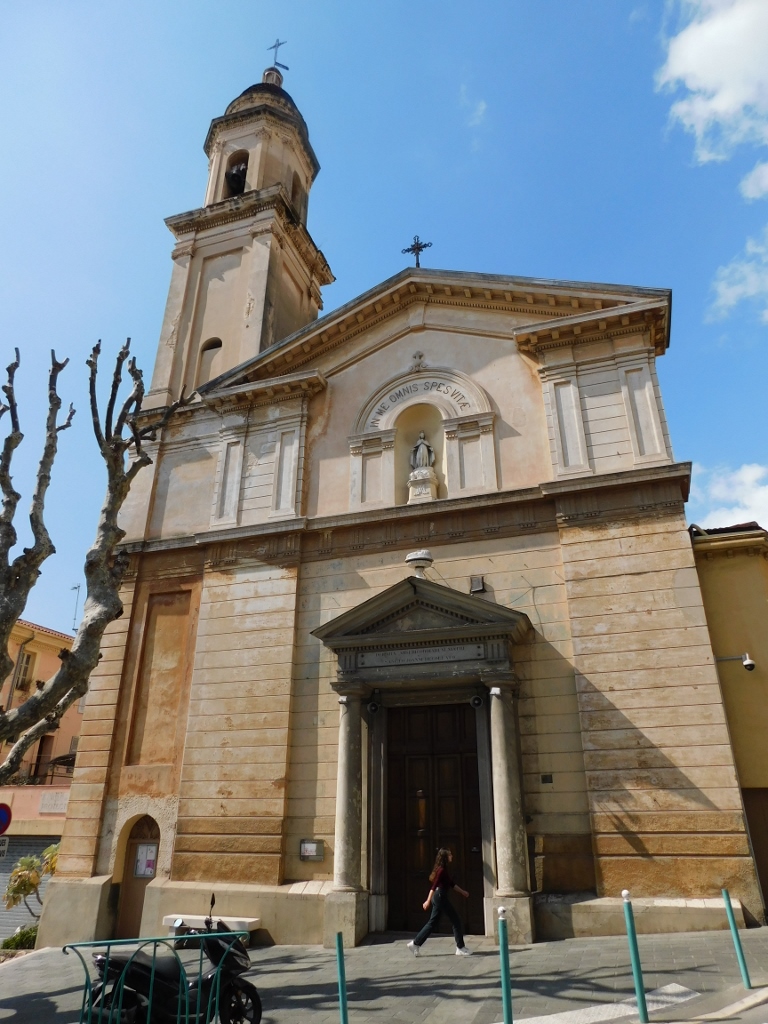 Chapel of Mercy
Chapel of Mercy
Then I went again to Rue Saint-Michel and there I made a fine break at a café enjoying the sun and yet tucked away from the cold wind that was more pronounced along the shore. Afterwards I continued along the same street and in the direction of the train station, passing by a few other interesting buildings.
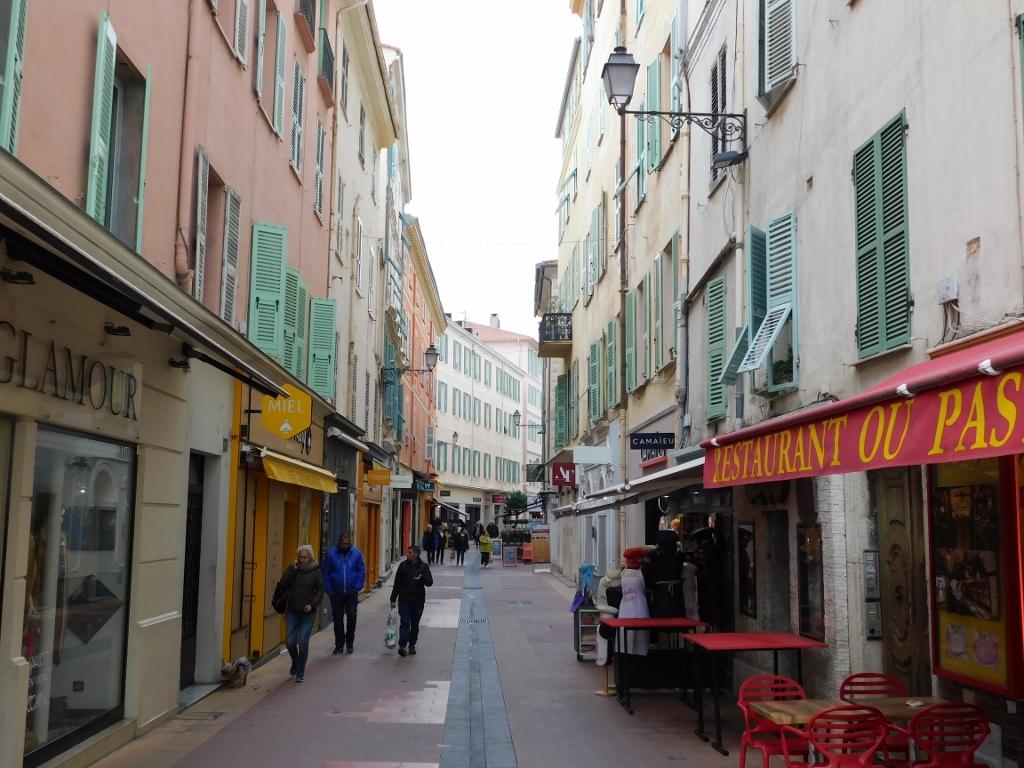 Rue Saint-Michel
Rue Saint-Michel
The first one was the Town Hall in which, as I’ve already mentioned, Jean Cocteau decorated the Wedding Hall. I must admit that I didn’t even attempt to go in. Maybe it would be permitted, but I simply did not have any more time.
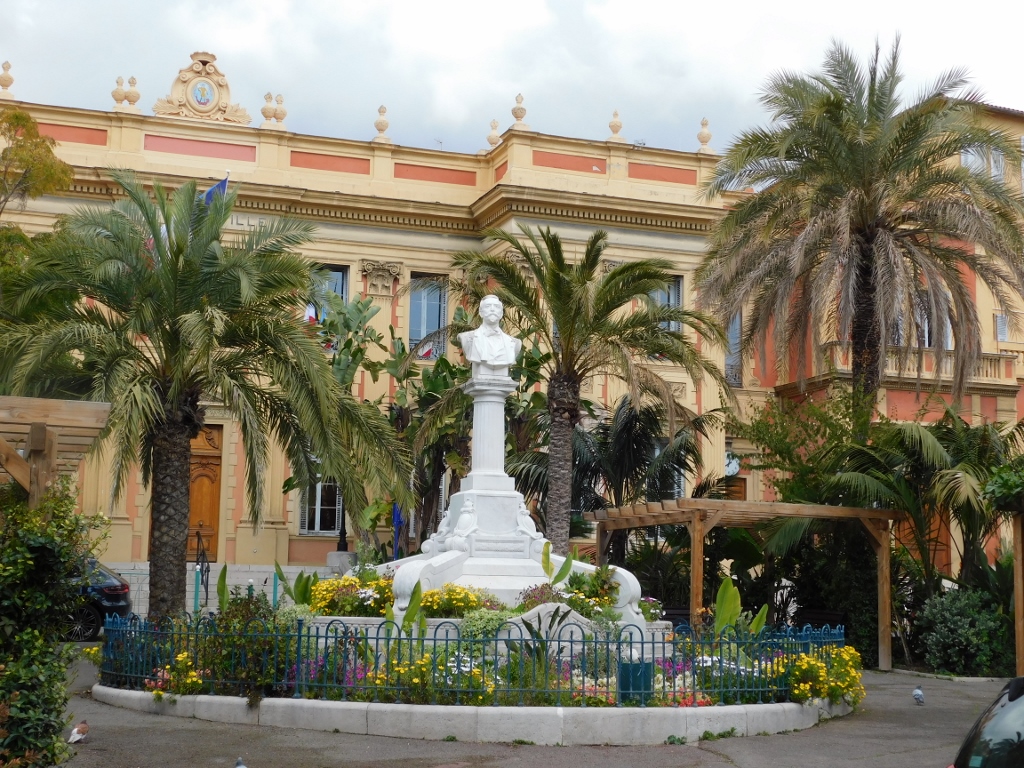 Town Hall in Menton
Town Hall in Menton
Then I walked past the Orient Palace in which the apartments are to rent, i.e., it serves for the stay of various guests, while the building has been made in an oriental style. It certainly stands out from its surroundings and also shows that this is a popular place among the visitors with deeper pockets.
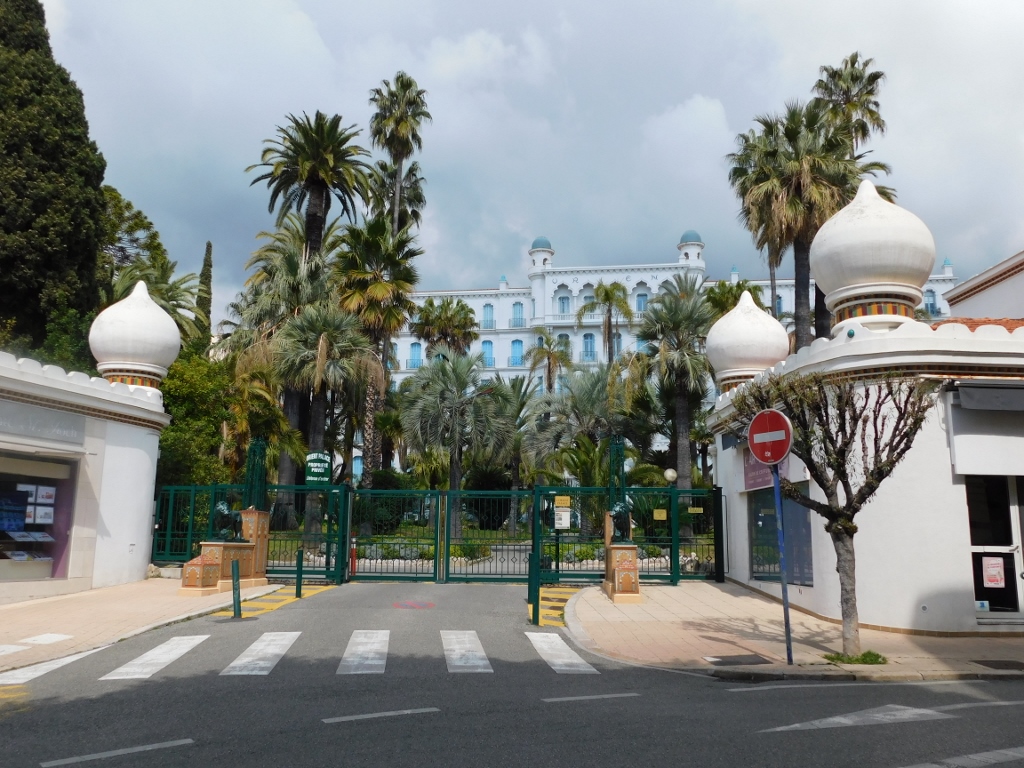 Menton, a detail
Menton, a detail
My route took me further beside a narrow and long public park, where I took a photo of the monument to La Marianne de Menton. By the way, Marianne is the national personification of the French Republic and it symbolises liberty, equality and fraternity, the values proclaimed during the French Revolution.
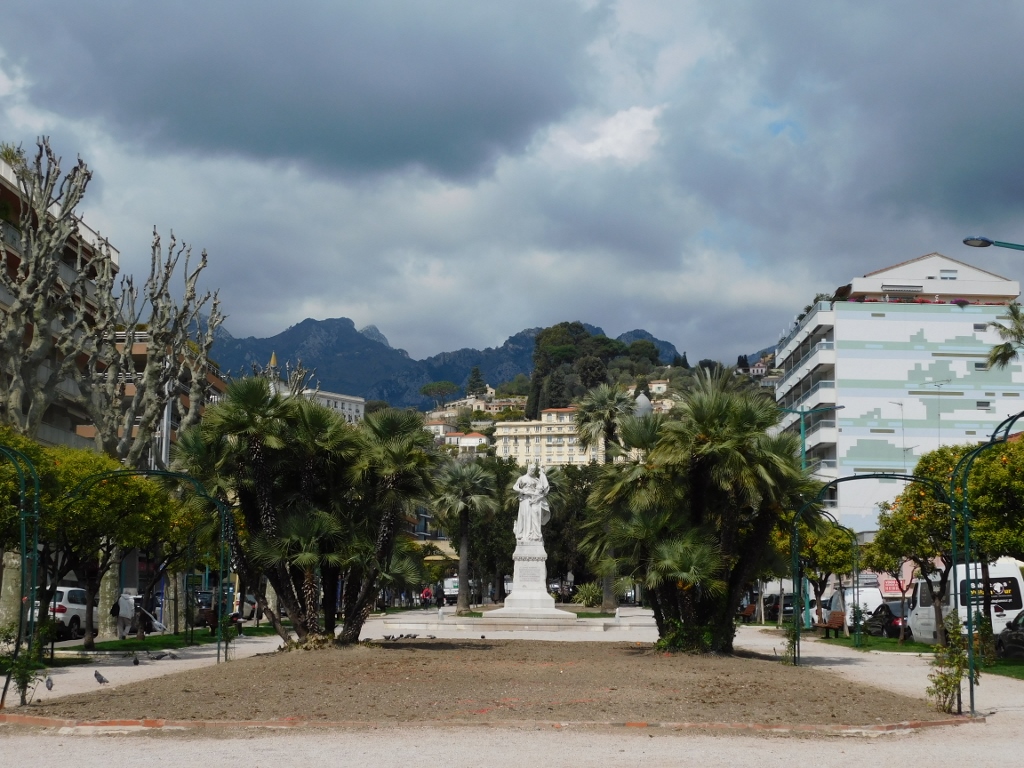 Marianne from Menton
Marianne from Menton
At some point, I could see the Winter Palace in the distance. The construction of the building started in 1901 and already in 1903 a luxury hotel was opened there. At the time, this was the place preferred by the English and Russian aristocracy who liked spending their winters under the mild Mediterranean sun, since the word on the street at the time was that the climate in Menton was the best in Europe.
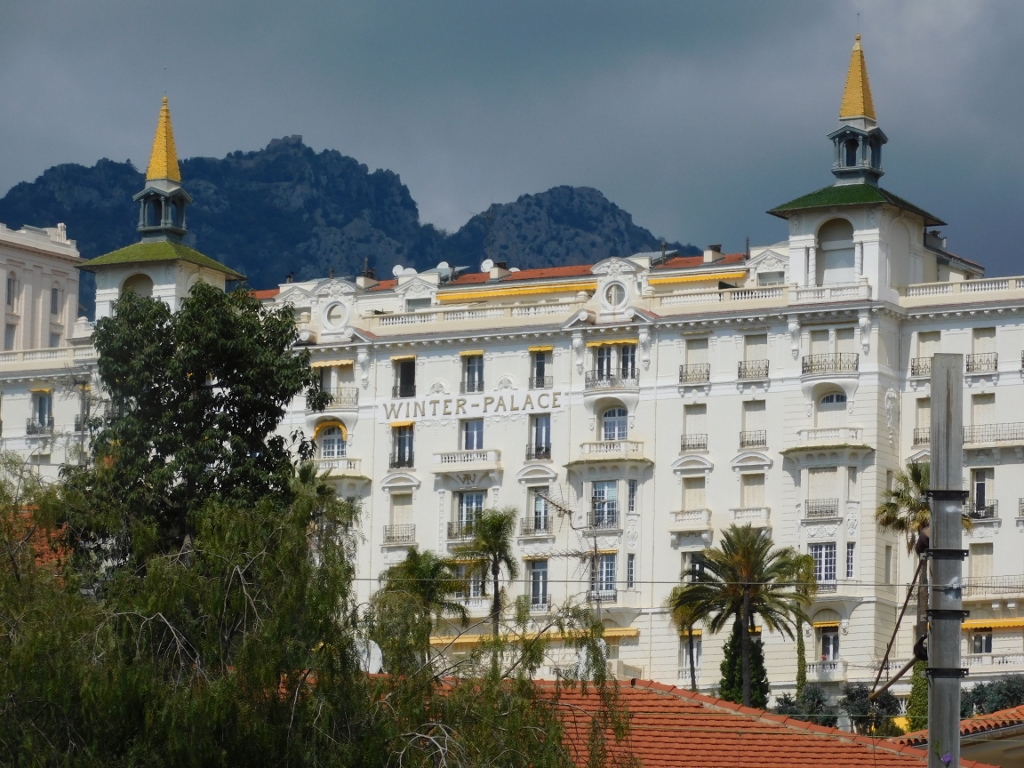 Winter Palace in Menton
Winter Palace in Menton
Today, this building is a historical monument of France, but it no longer serves as a hotel. Rather, it consists of some hundred flats that are privately owned by people of very different nationalities, but unquestionably very rich.